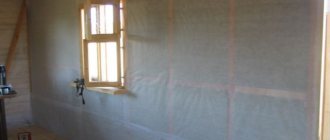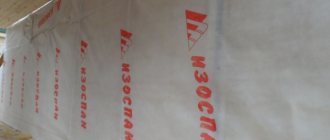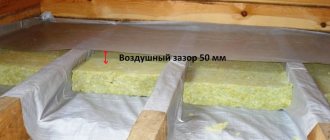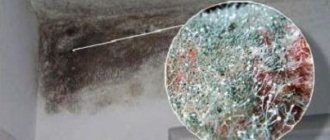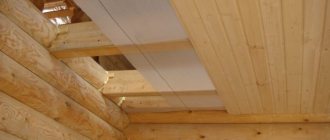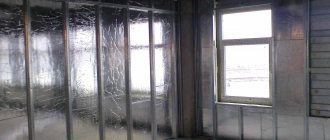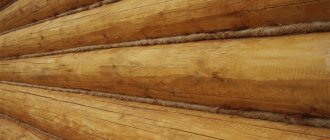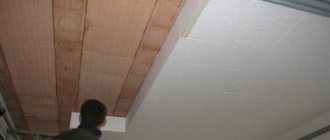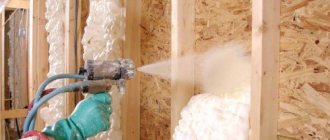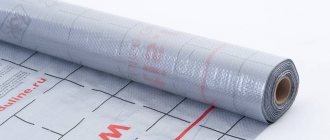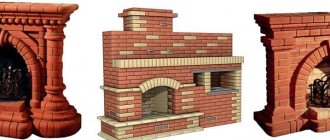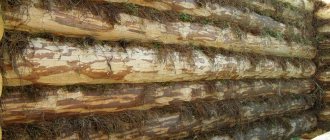Advantages and disadvantages
Vapor barrier prevents moisture from reaching the insulation, increasing its service life
Vapor barrier membranes are a more reliable way to protect structures and insulation from moisture. A conventional waterproofing film does not allow air and steam to pass in both directions. If placed outside the insulation, it protects against water entering from the outside. However, it is powerless against condensation from indoor air. At the same time, it is impossible to waterproof the insulation on both sides.
Izospan allows steam to pass through from the heat insulator, but protects against entry from the outside. This protection mechanism provides many advantages:
- Neither steam, nor condensation, nor moisture enters the heat insulator. Dry insulation lasts much longer.
- Walls, roofs, and frame structures protected from steam do not deform, do not rot, or become moldy.
- Izospan serves as a wind barrier - it prevents the penetration of cold or humid air.
- The film is light, elastic, durable. Installing a vapor barrier takes a couple of hours.
- Izospan is made from polypropylene. This is recyclable plastic - more environmentally friendly.
The disadvantages of the product include:
- installation is prohibited in conditions of high humidity, rain or fog;
- before laying, the material must be kept in a warm room for a couple of hours;
- the cost of Izospan is higher than that of conventional film.
The purpose of vapor barrier work
Wooden structures are very susceptible to moisture. This can cause the wood to swell and warp. The floor is an area that can come into contact with moisture on both sides. Soil moisture, as well as the constantly changing microclimate of the room, negatively affects the floor of the building.
In kitchens and bathrooms, water can often spill on the floor, although the humidity in these rooms is always high. This two-way bombardment of moisture can very quickly destroy the foundation or lead to the appearance of mold or mildew in the house.
In view of this, it is advisable to hydro and vapor barrier the floor in a wooden house. Thanks to such building material as Izospan for flooring, it is possible to qualitatively protect wood from moisture and condensation.
Recommendations and common mistakes
When laid on concrete, isospan acts as a vapor barrier, since almost any screed has good waterproofing characteristics. However, the manufacturer recommends following the accepted rules for installing the canvas.
Advice! In order not to completely get confused with the orientation of the material when laying the floor in a wooden house, lay the canvas with the printed logo facing up.
The biggest mistake is skimping on connecting tape. Instead, they try to lay the canvases with glue or stitch them with a stapler. This cannot be done, since in a wooden house the floor experiences significant loads, and even when poured into the screed, the edges will certainly separate.
Another mistake is the wrong choice of a suitable material; if in doubt, it is best to buy grades D or FD; the strength of the multilayer membrane is sufficient with a margin.
Characteristics of Izospan
It belongs to the group of construction films designed to protect against moisture. Such a membrane for the floor in a wooden house will serve as waterproofing for the floor, as well as a vapor barrier material. This will stop the processes of rotting and corrosion in the structure of the wood and thus significantly extend the service life of the base of the wooden structure.
Here are some advantages of this material:
- High strength.
- Absolute water repellency, which is not lost over time.
- Possibility of use both at low temperatures (-60ºС) and at high (+80ºС).
- Easy to install.
- Long service life (50 years warranty).
- Environmentally friendly.
- Protection from dampness and fungus.
- Acceptable price.
The disadvantages include:
- Low fire resistance.
- You need to be careful during installation, as due to inaccurate and sudden movements, the membrane may break.
Preparation for installation of a water vapor barrier layer
Laying a vapor barrier involves carrying out a number of preparatory works. First, you need to select materials for all layers, as they say, and also decide which vapor barrier is best for the floor. This “pie” consists of the following stages (starting from the top):
- Decorative floor covering.
- Plank floor.
- Vapor barrier.
- Counterrail.
- Thermal insulator (between the counter-batten boards).
- Water protection.
- Base floor.
We invite you to familiarize yourself with Insulation of floors in a bathhouse - All about the bathhouse
Preparation begins with the base floor itself. All boards, wooden blocks and other parts made of wood should be treated with a special disinfectant composition that prevents rotting, the formation of fungus, and also protects against insect attacks.
If we are talking about repairing the floor, and not about building a new building, then the finished floor boards, floor covering and existing vapor barrier on the floor must be removed in advance. All debris must be removed and then the wooden structure should be treated with an antiseptic.
Video. Which side to lay Izospan on?
|
|
|
|
Types of Izospan
There are several types of such material:
- Class A insulator.
- Class B insulator.
- Class C insulator.
- Class Isolator
Izospan A
This material is used as wind protection, as well as protection against condensation on the inside of the roof and walls. It is attached to the outside of the insulation for the roof or under the facing material for the facade. This wind-moisture-proof single-layer membrane improves the properties of insulation and extends the service life of the entire structure.
Izospan A is absolutely harmless. It is easy to use and has good mechanical strength.
The design of the roofing pie, starting from the inside, implies the following sequence:
- interior decoration,
- Izospan B,
- rafters,
- insulation (placed between the rafters),
- Izospan A,
- counter rack,
- roofing covering.
There is also Izospan AM. This three-layer membrane is designed for installation directly on top of the insulation. Which side should I lay Izospan AM on? It spreads with the red porous side inward.
Izospan B
This insulator already belongs to the category of hydro- and vapor barrier films. It is made of polypropylene.
Its outer side has a smooth laminated surface, while the other side has a porous or rough surface. Thanks to this surface, condensation can accumulate and then evaporate without penetrating into the insulation.
It is used to protect walls, partitions, roofs and interfloor and basement floors.
Izospan S
Instructions for use for floors, roofs and other areas show that it has hydro- and vapor barrier properties, but in this aspect it surpasses the performance of Izospan B. One side is smooth, and the other, with the help of a rough surface, retains drops of condensate, which subsequently evaporate.
To provide a vapor barrier for the floor in a wooden house, Izospan S plays an important role. For example, it is necessary when installing parquet or laminate flooring. If a concrete screed is poured onto the floor of a wooden house, hydro- and vapor barrier is provided by Izospan S. This insulator is also used for waterproofing roofs under metal tiles.
Izospan D
This is a universal polypropylene material that has very high strength. This vapor barrier floor membrane is used for concrete or earthen foundations where there is high humidity.
A special feature of the insulator is its resistance to ultraviolet radiation, which allows it to be used for covering temporary structures. Another plus is the ability to withstand snow loads.
Which Izospan is better to use for the floor?
Leading manufacturing companies can offer more than two dozen brands and varieties of insulating material for use in the construction of a ventilated facade, temporary waterproofing, and more often for assembling a roof or, more precisely, a roofing pie. It is clear that not all brands of isospan can be used for wooden and frame houses. For example, a fabric used in arranging a vapor barrier on a wooden ceiling must have high elasticity, strength and good vapor permeability, and withstand very high mechanical tensile loads.
For wooden baths and for heated floors, Izospan brands with an additional reflective coating are used. When laying floor tiles on concrete in a wooden house, you need Izospan with increased adhesive properties.
From the entire list of insulation brands for flooring, you can use the following:
- Brand D canvas;
- Izospan grades RS, RM and RF;
- Multilayer materials of the F series, these include FD, FS, FX;
- Izospan grade C;
- Brand B canvas.
The latter option is best suited for tiling. It is easier to lay Izospan C on a subfloor using glue, since one of the sides is rough, which ensures normal wettability and adhesion of the glue.
All of the listed brands of Izospan have one common property: they are practically impermeable to water vapor and completely impermeable to liquid water. The strength of the material is not the highest, but it is quite sufficient for laying on a concrete floor in a wooden house.
If you don’t know which one is better, use a universal one – brand D
Izospan B
Izospan B, which is very similar in characteristics to grade “C”, is recommended to be laid on the floor only when arranging interfloor ceilings; it is more often used for the walls of internal partitions of wooden houses. If you are looking for a compromise option for the floor in a frame house, then Izospan V may be a good solution, but only for a rough panel base. The canvas does not have a reinforcing mesh, so any attempt to use Izospan for flooring along joists will lead to deformation and breaks of the film at the attachment points.
Structurally, it is a two-layer material made of a propylene non-woven base and polyethylene film. The fabric is soft, holds steam and water well, but the strength is too low. It is 2-3 times less than other materials from the list; the sample can withstand a tensile load of 13 kg and 7 kg in the longitudinal and transverse directions, respectively. If you take the instructions for using Izospan B for the floor, it becomes clear that the base must be as rigid as possible, otherwise a hernia or bubble may appear on the canvas, through which moisture can easily reach the wooden parts of the house.
Izospan S
One of the most common lining materials, it is popular due to its high ductility and good insulating properties. It is a two-layer fabric made of a non-woven polypropylene base, reinforced with a fairly thick polyolefin film. The film surface is smooth, the reverse side has a pronounced roughness.
The strength of Izospan C is 40% higher than that of grade B canvas. Moreover, externally, the two options for vapor and waterproofing can only be distinguished visually; grade C has a darker shade, and they are almost identical to the touch.
If Izospan B can be laid on a floor made of wooden slabs on a concrete base or plywood, then grade C sheets are recommended to be used only on concrete.
Izospan D
The most durable of all those presented in the line, absolutely impenetrable to water vapor and liquid moisture, the material is ideal for various types of insulation in a wooden house. The tensile strength of the fabric is about 100 kg, which is 8-9 times more than for the above brands.
Advice! Due to its enormous strength, Izospan D is used for floors as “dirty” waterproofing; the fabric can be laid directly on the ground, on a backfill with gravel sand, or under the base of a wooden house.
Izospan D is considered a universal insulating material for any floor in a wooden house
It is allowed to lay Izospan on the floor of a wooden house on a base raised above the ground. The canvas provides reliable waterproofing and can withstand loads even in the presence of slight deformations of the wooden load-bearing elements of the floor.
Izospan RS and RF
R series insulation is manufactured in the form of a thermally bonded sheet of three layers:
- Polypropylene non-woven base;
- Reinforcing mesh;
- Polyethylene film with a smooth surface.
Initially, the RM panel was developed for flat roofs, and therefore for high crushing loads on wooden rafters of flat roofs. The reinforcement scheme provides high tensile strength, which is 35-39 kg, with the ductility of the waterproofing. Recommended for use for pouring concrete floors in wooden houses, in conditions of unstable alternating load on the floor covering.
In Izospan RF, instead of polyethylene, a polypropylene layer with a metallized surface is used. The canvas is ideal for arranging heated floors in the form of a screed on a wooden base. The strength of the RF brand is 20% higher than that of RS, therefore Izospan is used as additional insulation of the floor in a wooden house, for walls, plinths and ceilings.
F series materials
All insulating panels in the F line are made on the basis of polypropylene fabric with an outer layer of thin film with a metallized coating. The most durable Izospan FD has a tensile strength of 80 kg. It is used for concrete floors in wooden houses with irregular heating and traveling residence of the owners. FS fabrics are similar to FD, but have lower strength.
FB grades are kraft paper with a Dacron coating and a layer of metallized coating. Used for reflective insulation of the floor in a wooden bath.
The FX canvas is made on a foamed polypropylene backing, so Izospan can be used as insulation for floors made by self-leveling on a wooden panel base.
Is it possible to use Izospan A for floor insulation?
Class “A” polypropylene panels have good vapor permeability, but some brands can also be used as additional insulation for floor insulation.
For example, according to the instructions for using Izospan AM for floors, it is allowed to use the material as a backing for the insulation of wooden floorboards, provided that the main layer of insulation has good vapor permeability. Ideal for a bath. In this case, Izospan, as waterproofing for the floor in a wooden house, provides protection against the reverse suction of condensate accumulated along the bottom of the film.
Required tools and materials
To work with Izospan B, you need to ensure that you have a certain number of tools:
- scissors - for cutting material;
- tape measure or ruler - for applying dimensions and measuring material;
- fastening elements - nails, self-tapping screws, both options are used with galvanization;
- adhesive tape used in construction - for gluing the joints of individual sections of material;
- stapler - will allow you to quickly attach Izospan V to the base (used only for wooden bases);
- slats, metal profiles - they can also be used to fasten the material, but the need for their use will depend only on the type of final finishing of the room.
What is needed to work with Izospan
Preparation for installation of a water vapor barrier layer
Installation of Izospan V involves a number of preparatory works. In general, the floor pie in a wooden house is the following design:
- rough base;
- wooden logs;
- thermal insulation layer;
- waterproofing;
- finishing floor;
- finishing coating.
You should not violate the technology for installing a wooden floor, because otherwise the structure will turn out to be unreliable. The entire pie should ideally rest on brick or concrete supports, with a small ventilated area between the soil and the wood floor. The vapor barrier should be installed immediately during the construction of the house; there is no need to postpone this stage “for later”.
Vapor barrier will reliably protect against moisture and condensation
Preparations before laying the vapor barrier membrane are as follows. To begin with, all wooden parts of the floor pie are treated with a special protective compound, which will allow the tree to acquire immunity to rot and fungus for the longest possible period. Particular attention should be paid to wooden joists and the rough floor, on which the membrane material will be laid.
On a note! If the vapor barrier layer is planned to be installed in an already finished building, then before doing so it is recommended to replace all the old elements with new ones. This is a replacement of insulation and worn elements of the subfloor.
Connecting tape (adhesive tape) Izospan FL
Which side to lay the vapor barrier
When installing a vapor barrier, it is necessary to strictly adhere to the technology, otherwise the system will not function effectively. And here one of the important points is which side the vapor barrier sheet will be laid in relation to the insulation.
Not all manufacturers indicate this on the film or indicate this in the instructions, so you should adhere to the basic rules for installing vapor barriers:
- The smooth side of the double-sided film is always placed on the insulation, and the rough side is on the outside. The fleecy surface absorbs and retains steam and moisture well inside, preventing it from passing to the heat insulator.
- Single-sided laminated polypropylene film is also laid with the smooth side inward and the woven side outward.
- Films with foil coating are placed with the aluminum side facing the room.
- When rolling out any rolled vapor barrier, the outer part is inside the roll, and the inner part is on top.
- If the two sides of the film are different colors, the outer surface will be the one that is darker.
- Conventional polyethylene films have two identical surfaces, so they can be laid on either side.
We invite you to familiarize yourself with the Bathhouse with a gazebo - the advantages of a bathhouse with a gazebo under one roof. Review of projects, stages of construction. The best ideas for implementation
The waterproofing layer involves not only the insulation itself, but also intermediate materials that form the frame and thermal insulation.
Laying such structures involves performing several preparatory operations:
- First of all, you should inspect the old base for damage. If the floor is made of wood, it is important to remove rot and sagging boards. But waterproofing is best done on a concrete slab, especially if the surface is on the ground floor. The floors between floors must be checked for strength and quality.
- If the surface is ready for decorative finishing, then the base should be treated with special strengthening solutions. For wood, impregnations are used that increase resistance to burning and rotting. Floors without screed are treated with strengthening primers.
- When the surface is ready, the subfloor should be formed. In some cases, it is built directly on the ground. But this approach will not allow the wood to last long. Therefore, it is better to use concrete screeds as rough foundations, on which logs for finished wooden structures are laid.
Arranging a protective “pie” consists of the following sequential actions:
- The procedure begins with waterproofing the subfloor. To do this, the film is rolled out over the entire surface, placing it between the lags. It is important to fasten it in such a way that there is no tension. If the width of the sheet is not enough, it is joined to another, forming an overlap of at least 20 cm. When everything is fine, the material is attached to the base using adhesive tape, staples or special nails.
- Insulation is installed on top of the film. Its fastening is carried out differently depending on the selected substance. If wooden logs are used, then mineral wool is inserted between them. It should fit tightly between them without forming gaps.
- At this stage, a vapor barrier membrane is spread on top of the insulation. It is also joined using an overlap. All joints are glued with tape to prevent moisture from penetrating through them.
The procedure ends with the installation of the decorative floor. As you can see, installing a water vapor barrier is not very complicated.
To learn how to install roll waterproofing, watch the video.
carried out at the stage of its insulation
In some cases, when installing a floor, along with thermal insulation material, not one, but two layers of vapor barrier are laid at once. The first layer is placed between the insulation and the subfloor. This protects the material from vapors that rise from the ground. Note that this method is used quite rarely.
- PVC film;
- special membrane.
Carrying out work on laying a vapor barrier membrane
Laying Izospan B does not require any special skills or knowledge. Even a novice master can handle the material.
Step 1. The required amount of Izospan V material is purchased. It will be equal to the size of the floor area, to the value of which a certain amount of material required for the overlap is added. This is approximately 15-20% of the total area of Izospan V.
First you need to purchase suitable material
Step 2. A number of preparatory works are carried out in advance, as mentioned above. Next, insulation is laid between the joists.
Laying insulation between joists
Step 3. The vapor barrier material begins to be laid on the outermost joists from one of the walls. It is best to start installation from the wall farthest relative to the exit. The material is laid in such a way as to cover the joists well. The rough side of the material should face the insulation.
Example of laying vapor barrier material
Step 4. To attach Izospan B, it is best to use a stapler. The material is targeted to the joists.
Fastening the material with a stapler
Step 5. The next piece of material is laid overlapping the previously laid and secured one. The overlap width is at least 15 cm.
The material is laid with an overlap
Advice! There should be a small gap between the insulation and Izospan - 4-5 cm. It is necessary for ventilation of the materials.
Step 6. Two Izospan B sheets in the overlap area are glued together using adhesive tape. This will allow you to achieve a certain tightness of the vapor barrier layer.
Adhesive tape is used to glue the canvases together
Step 7. It is recommended to additionally protect the lower part of the floor structure with a vapor and waterproofing layer of Izospan D material. It is also fastened using a construction stapler.
Izospan D
Step 8. It is recommended to glue the joints of Izospan B to wooden structures with special Izospan ML tape.
An example of using Izospan ML tape
On a note! In case of mechanical damage to the material web, it must be repaired. To do this, you can use special glue or Izospan tape.
Types of vapor barrier materials
For a high-quality vapor barrier layer, the most modern materials available on the market are currently used. In wooden buildings, the following materials can be used to protect floor coverings from steam:
- polyethylene film;
- polypropylene film;
- diffuse membrane;
- liquid rubber.
We invite you to familiarize yourself with DIY bath shelves drawings
Often, when creating a vapor barrier, polyethylene film is used. Speaking about this material, we note that it is produced in several varieties. Most often used:
- film with perforated side;
- film with non-perforated side;
- material with a reflective coating on one side.
When it is necessary to perform high-quality waterproofing work, perforated film is used. The remaining two types are used to create a vapor barrier layer. Polyethylene film has several advantages. Let us identify the two most important ones: low price and availability of material.
This polyethylene film also has its disadvantages. When used indoors, a greenhouse effect is achieved. Therefore, to avoid this, when creating a vapor barrier using this material, a ventilation gap is created. Working with this film, a vapor barrier layer is created without connecting seams.
Another vapor barrier material, polypropylene film, is more modern among the materials in this group. It is highly durable. It contains viscose-cellulose fibers, which prevents the penetration of steam into the floor covering, thereby preventing the formation of condensation.
Polypropylene film reacts quite quickly to changes in the level of humidity in the room, removing all trapped vapors. The main advantages of this material are:
- affordable price;
- ease of installation;
- long service life.
Diffuse membranes
A vapor barrier membrane is a coating that has the ability to allow air to pass through. One of the characteristic features of diffuse membranes is a high degree of vapor permeability. In addition, such material is able to regulate the microclimate in the room based on air temperature. To create a vapor barrier for the floor, both one-sided and two-sided varieties of material can be used.
Liquid rubber
The material is mainly used for waterproofing and vapor barrier work on concrete-based coatings. Bitumen-polymer compounds are the main component in the production of this material. Liquid rubber is characterized by high heat, hydro and vapor barrier properties.
Next comes the installation of vapor barrier. In truth, both layers of the membrane will serve as both a hydro- and vapor barrier. This layer serves as a barrier to the penetration of moisture from the soil into the subsequent insulation. Here you can use Izospan V.
But how to put Izospan? Film from rolls is overlapped by 15-20 centimeters. Vapor barrier installations on floors must be securely connected using adhesive tape or double-sided tape. This helps avoid cracks and gaps where moisture can penetrate.
This film should be attached to the joists using a stapler or galvanized nails.
When laying Izospan vapor barrier, the question arises: which side to lay the insulator on. To prevent condensed moisture from penetrating into the insulation and possibly evaporating over time, you need to lay the material with the smooth side facing it.
Laying insulation
The heat-protective layer is laid between the joists. The thickness of the material should be at least 5 cm, but it is clear that the larger it is, the better. The most commonly used are polystyrene foam or mineral wool.
When laying the material, you must ensure that it fits snugly against the wooden joists and insulator.
This layer, just like the first one, should overlap by 15-20 centimeters. Izospan S is used for this insulation layer.
We recommend that all joints need to be glued. If the manufacturer says that the connection must be made using tape, then there is no need to look for an alternative. This can lead to poor-quality gluing of joints. It is better to spend a little on materials than to later discover that excessive savings have led to moisture and vapors penetrating through the cracks.
It’s good if, when attaching a vapor barrier to the joists or counter-batten, the film sags a little, and there is also a small gap between it and the insulation. This will be the ventilation gap.
In addition, you need to slightly (several centimeters) wrap the film on top and attach it to the wall with adhesive tape.
When laying Izospan, you need to correctly determine which side to lay it towards the insulation. Incorrect placement of the film can lead to it simply not performing its functions.
A finished floor is laid on top of the second insulating layer. Then you can install laminate, parquet or any other floor covering on it.
Having carried out all the work on insulating the floor efficiently, you don’t have to worry that excessive dampness will very soon damage the floor covering.
Izospan for the floor: types and purposes
All Izospan products are divided into four categories:
- Waterproofing, windproof, vapor-permeable membranes. They are mainly used for roofing and facade insulation. In the construction of the floor, it may be required as protection against blowing and wetting of the rough flooring on a pile or pile-grillage foundation. They are used in floors with mineral wool insulation. They allow you to maintain normal humidity inside the insulation.
- Vapor barrier waterproof films. Material from this category is usually placed on concrete preparation when installing a concrete floor on the ground, in the floors of the second floor or above the basement.
Types and types of materials Izospan - Reflective steam-heat-waterproofing films. They are distinguished by the presence of a layer of foil. This material can also be used as a vapor barrier. The foil layer copes with this task perfectly, but keep in mind that it will work to save energy only if there is an air gap of at least 3 cm above the foil. That is, it should be laid to reflect heat only in the construction of floors along the joists. This material does not provide a thermal insulation effect in concrete.
- Connecting tapes. Almost all Izospan films are sold in rolls 1.6 meters wide. Over large areas they are laid in several stripes. The edges of the strips need to be connected. This is what connecting tapes are made for. The material also needs to be placed on the walls and secured there, ensuring a sufficient degree of insulation.
In principle, Izospan for the floor can be selected in such a way as to solve any problem of protecting structures from moisture in any of its manifestations. The quality of the films is good, but there are a considerable number of fakes that do not differ in quality.
Vapor barrier films and their features
This section will talk about Izospan vapor barriers. All of them have a wide operating temperature range from -60°C to +80°C. What are their differences? If you look at the comparison table, you will see that Izospan B differs from Izospan C, D, Rs, RM and DM only in tensile and tensile strength. Their other characteristics are the same. So it is strength that is the defining characteristic.
Characteristics of vapor barrier membranes that are recommended for use in floor construction
There are some differences in the structure:
- Izospan RS is a three-layer reinforced material consisting of polypropylene film and non-woven fabric reinforced with strong fibers.
- Izospan B, D and C - two-layer - made of film and non-woven fabric (without reinforcement). They differ in density and strength.
Reinforced materials Izospan DM and RS for vapor-waterproofing layer - Izospan DM is a high-strength vapor barrier. Polypropylene fabric was used as a base (pictured on the right). This material prevents the penetration of insulation particles into the air, and its structure is such that condensation does not form on it.
- Izospan RM is a reinforced material made of polyethylene film and polypropylene non-woven fabric.
Instructions for using vapor barrier Izospan V, C, D
Izospan vapor barrier films are also waterproofing. They do not allow water or steam to pass through. What are the differences between Izospan A and B? The fact is that B does not let steam through, A does. That's it in short.
Made from different materials. There are films, nonwovens and fabrics made of polyethylene and polypropylene. Fabric-based materials have very high strength characteristics. Their use is justified in places where they may be subject to high mechanical loads. Technical characteristics of Izospan vapor barrier films are given in the table.
Name Maximum elongation in the transverse/longitudinal direction N/50 mm Vapor permeability Withstands water pressure, mm.w.c. Withstands ultraviolet (without protective coatings) at least, months
| Izospan RS (рс) | 413/168 | No | 1200 | 3-4 |
| Izospan B and B fix | 130/107 | No | 1200 | 3-4 |
| Izospan S | 197/119 | No | 1200 | 3-4 |
| Izospan RM (rm) | 399/172 | No | 1200 | 3-4 |
| Izospan D (D) and D fix | 1068/890 | No | 1200 | 3-4 |
| Izospan DM (DM) | 700/650 | No | 300 | 3-4 |
The main task of these materials is to cut off steam from the insulation as efficiently as possible and at the same time provide protection from moisture. A “side” but important effect is protection against the penetration of mineral wool particles into the indoor air. It is used in the construction of walls, ceilings, roofs, and when constructing concrete floors. Vapor barriers are often part of the “pies” above, simply because they perform other tasks.
Rules for installing vapor barriers
The main task when laying vapor barrier films is to achieve as complete a seal as possible. It is necessary to let as little steam as possible into the insulation. We make all connections reliable using sealing and connecting tapes. The basic rules of vapor barrier do not differ from those described above:
- On the walls and roof we start from the bottom.
- The next canvas overlaps the first by 10-20 cm.
- We make vertical joints with an overlap of at least 20 cm.
Vapor barrier materials are usually installed from the inside of the room
- We glue all connections with double-sided tape.
- We make connections to building materials using mounting and connecting tapes.
- When used for flat roofs and ceilings, the vapor barrier is applied to the walls and sealed there.
